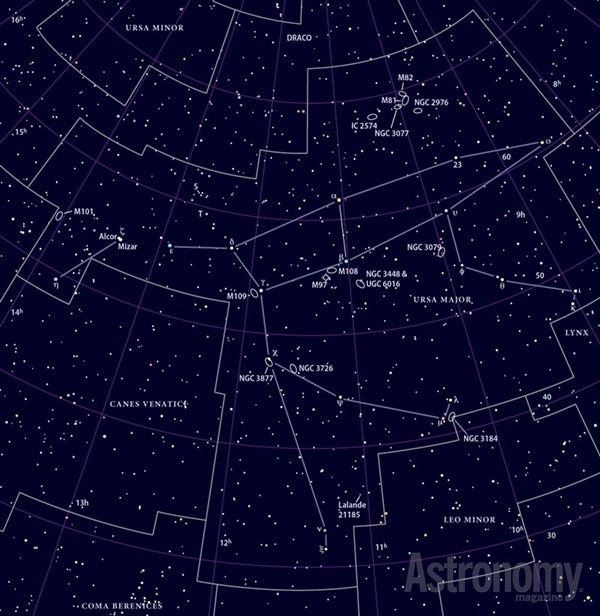Targets for May 19–26, 2016
Naked eyes: Double star Pulcherrima
Small telescope: The Owl Nebula (M97)
Large telescope: Barred spiral galaxy M108
This week’s naked-eye object is the double star Pulcherrima in Boötes the Herdsman, also known as Epsilon (ε) Boötis. Although you can find this star easily without optical aid, you will require a telescope to glean all that it has to offer.
This star’s original name is Izar, which means “the girdle.” That’s not an appealing name, but it does describe where the star sits, in the middle of the figure of Boötes.
The name Pulcherrima came to Epsilon in 1829 when Friedrich George Wilhelm von Struve discovered that it was a double star. Pulcherrima is a Latin term meaning “most beautiful,” and Struve christened the star with this name because of its gorgeous contrasting colors.
The two components sit closely together — the separation is only 2.8″ — so you’ll need a magnification above 150x to split the stars cleanly. The primary is an orange giant star that shines at magnitude 2.7. Its companion resembles the Sun in size, but it glows at magnitude 5.1 with a blue-white light.
A hoot in the Great Bear
This week’s small-telescope target is a planetary nebula known as the Owl Nebula (M97) in Ursa Major. To find it, look 2.3° southeast of Merak (Beta [β] Ursae Majoris). The planetary glows at magnitude 9.9 and measures 194″ across.
The Owl Nebula is one of the best springtime planetary nebulae visible to Northern Hemisphere observers. That said, this object has quite a low surface brightness, so you’ll need a dark sky and some patience to view its details through a 4-inch telescope.
Astronomers long ago dubbed this object the Owl because of the two dark circular regions visible within its disk. Each eye measures slightly less than 1′ across, and the northwestern one appears a bit darker.
Pierre Méchain discovered this object February 16, 1781, but it was William Parsons, third earl of Rosse, who first called it the Owl Nebula. In March 1848, he described, “Two stars considerably apart in the central region: dark penumbra around each spiral arrangements.” During other observations, Rosse saw only one star and called the spiral form doubtful.
M97’s orientation may be responsible for the owl’s “eyes.” Some astronomers have speculated that this nebula is a torus (a sphere with a hollow cylinder from pole to pole) tilted to our line of sight so the cylinder’s ends — where material is thinnest — form the eyes.
You’ll need a big scope to spot the 16th-magnitude central star. It lies between the two eyes. Because the Owl Nebula has a low surface brightness, use an Oxygen-III filter and a magnification of about 100x to see it best.
If you can view it through an 11-inch or larger telescope, look for the size discrepancy between the eyes. Finally, if your sky is really dark, you may see the disk’s outer 10 percent as a faint ring.
Belly up to the bar
This week’s large-telescope target is barred spiral galaxy M108, another Messier object in Ursa Major. Here’s a great target for a large telescope. Not only is M108 a relatively bright magnitude 10.0 barred spiral, but also it sits edge-on to our line of sight.
M108 tilts from the east-northeast to the west-southwest and measures 8.1′ by 2.1′ — four times as long as it is wide. You can find it 1.5° east of magnitude 2.3 Merak.
You’ll immediately see the 12th-magnitude star that lies between us and M108’s core. This stellar luminary has tricked many an observer into thinking they’d found a supernova. Don’t let it fool you.
Few amateur telescopes will allow you to trace much of M108’s spiral arms. If you’re lucky enough to observe this object through a 16-inch or larger scope, however, look for a subtle darkening running along the galaxy’s northeast side. That region appears less luminous because it’s a massive dust lane in M108’s star-forming areas.
Expand your observing at Astronomy.com
The Sky this Week
Get a daily digest of celestial events coming soon to a sky near you.
Observing Basics
Find more guidance from Senior Editor Michael E. Bakich with his Observing Basics video series.










